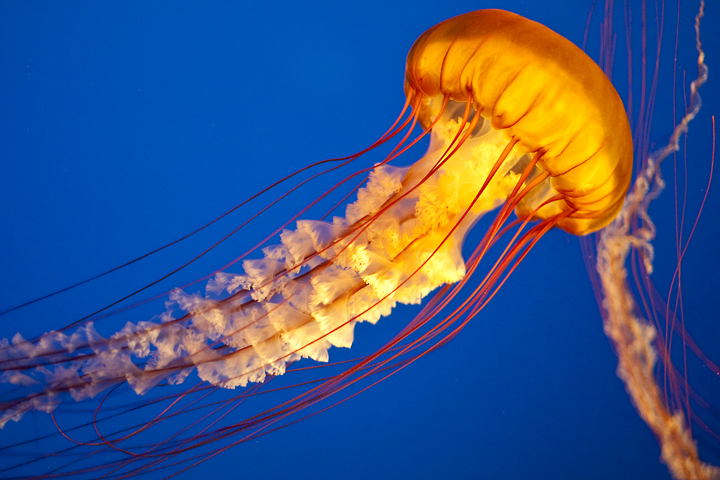
This is the jellyfish caption
Jellyfish or jellies[1] are the major non-polyp form of individuals of the phylum Cnidaria. They are typified as free-swimming marine animals consisting of a gelatinous umbrella-shaped bell and trailing tentacles. The bell can pulsate for locomotion, while stinging tentacles can be used to capture prey.Jellyfish belong to Medusozoa, the clade of cnidarians which excludes Anthozoa (e.g., corals and anemones). This suggests that the medusa form evolved after the polyps.[38] The phylogenetics of this group are complex and evolving. The Medusozoa and Octocorallia are proposed as sister groups according to research published in 2012. That research also proposes coronate Scyphozoa and Cubozoa as a sister clade to Hydrozoa and discomedusan Scyphozoa, which are themselves sister groups. The hydroidolinans are a sister group to Limnomedusae, also called Trachylina. Semaeostomae is paraphyletic with Rhizostomeae. The class Storozoa was the earliest group of Medusozoa to diverge and the Limnomedusae were the earliest Hydrozoa to diverge.[39] The four major classes of medusozoan Cnidaria are: Scyphozoa are sometimes called true jellyfish, though they are no more truly jellyfish than the others listed here. They have tetra-radial symmetry. Most have tentacles around the outer margin of the bowl-shaped bell, and long, oral arms around the mouth in the center of the subumbrella. Cubozoa (box jellyfish) have a (rounded) box-shaped bell, and their velarium assists them to swim more quickly. Box jellyfish may be related more closely to scyphozoan jellyfish than either are to the Hydrozoa.[38] Hydrozoa medusae also have tetra-radial symmetry, nearly always have a velum attached just inside the bell margin, do not have oral arms, but a much smaller central manubrium with terminal mouth opening, and are distinguished by the absence of cells in the mesoglea. The majority of hydrozoan species maintain the polyp form for their entire life cycle and do not form medusa at all (such as hydra, which is hence not considered a jellyfish). Staurozoa (stalked jellyfish) are characterized by a medusa form that is generally sessile, oriented upside down and with a stalk emerging from the apex of the "calyx" (bell), which attaches to the substrate. Some Staurozoa (all? - it is not known yet) also have a polyp form that alternates with the medusoid portion of the life cycle. Until recently, Staurozoa were classified within the Scyphozoa.
Jellyfish are found in every ocean, from the surface to the deep sea. Scyphozoans are exclusively marine, but some hydrozoans live in freshwater. Large, often colorful, jellyfish are common in coastal zones worldwide. Jellyfish have roamed the seas for at least 500 million years,[2] and possibly 700 million years or more, making them the oldest multi-organ animal.[3]Some jellyfish have ocelli: light-sensitive organs that do not form images but which can detect light and are used to determine up from down, responding to sunlight shining on the water's surface. These are generally pigment spot ocelli, which have some cells (not all) pigmented. Certain species of jellyfish, such as the box jellyfish, have more advanced vision than their counterparts. The box jellyfish has 24 eyes, two of which are capable of seeing color, and four parallel information processing areas or rhopalia that act in competition,[26] supposedly making it one of the few creatures to have a 360-degree view of its environment.[27] The eyes are suspended on stalks with heavy crystals on one end, acting like a gyroscope to orient the eyes skyward. They look upward to navigate from roots in mangrove swamps to the open lagoon and back, watching for the mangrove canopy, where they feed.[3]

This is the jellyfish caption